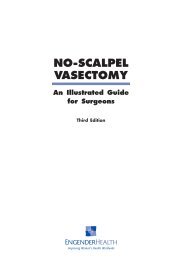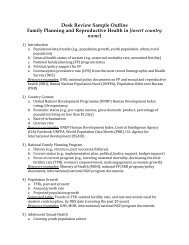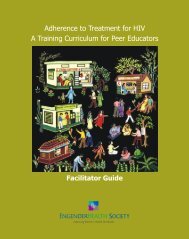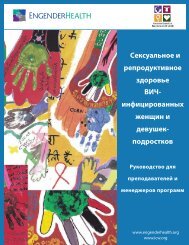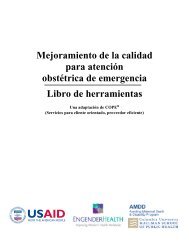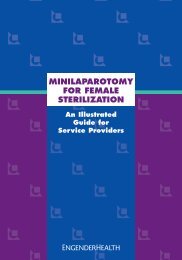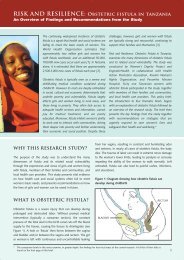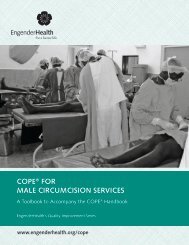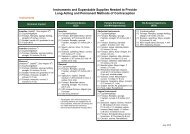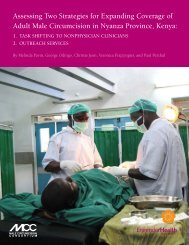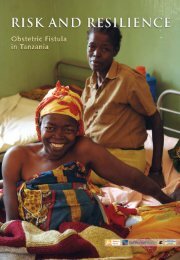Help-Seeking Pathways and Barriers for ... - EngenderHealth
Help-Seeking Pathways and Barriers for ... - EngenderHealth
Help-Seeking Pathways and Barriers for ... - EngenderHealth
Create successful ePaper yourself
Turn your PDF publications into a flip-book with our unique Google optimized e-Paper software.
included rape by a stranger, the threat or use of a weapon, <strong>for</strong>ced anal sex, <strong>and</strong> severe<br />
physical abuse by a husb<strong>and</strong> or partner.<br />
<strong>Help</strong>-seeking from any source is very low.<br />
One of the most important findings is that violence is infrequently reported to anyone,<br />
including medical personnel or the police. This is consistent with national statistics that<br />
indicate the low prevalence of help-seeking among survivors of GBV. The results powerfully<br />
highlight the normative influences <strong>and</strong> structural barriers that prevent most women from<br />
seeking any help after experiencing violence <strong>and</strong> from receiving appropriate care if they do<br />
seek help.<br />
Survivors are expected to rely on the family <strong>for</strong> help.<br />
Findings from “<strong>Pathways</strong> of <strong>Help</strong>-<strong>Seeking</strong>” maps drawn by PFG participants <strong>and</strong> ensuing<br />
discussions revealed that even when a survivor does seek help, her pathway frequently<br />
begins <strong>and</strong> ends with the family. For example, a married woman who experiences partner<br />
violence is expected to first speak with her husb<strong>and</strong>’s family members. While some<br />
mechanisms exist <strong>for</strong> family meetings to address such marital issues, the ultimate goal of<br />
any actions taken is to reconcile the marriage, <strong>and</strong> not necessarily to address the woman’s<br />
needs or concerns. It is only when a problem cannot be solved within the survivor’s family<br />
or immediate social network that a survivor might consider seeking help from external or<br />
more <strong>for</strong>mal sources of support.<br />
Formal support services <strong>for</strong> survivors are limited outside Dar es Salaam,<br />
particularly in rural areas.<br />
More comprehensive services <strong>for</strong> GBV survivors are increasingly available in Dar es Salaam,<br />
including Gender <strong>and</strong> Children’s Desks in police stations <strong>and</strong> several promising civil society<br />
interventions, such as the Women’s Legal Aid Centre (WLAC). However, women’s awareness<br />
of <strong>and</strong> access to care <strong>and</strong> support services – local government, healthcare, police, <strong>and</strong> legal<br />
assistance – were all limited in study sites outside Dar es Salaam particularly in the rural<br />
districts examined.<br />
<strong>Help</strong>-seeking frequently follows a circuitous pathway.<br />
Formal referral networks that integrate services across sectors are also virtually nonexistent,<br />
making it extremely difficult <strong>for</strong> those survivors who do seek care to navigate the<br />
system. The pathways maps, discussions, <strong>and</strong> KIIs also revealed that referrals are required<br />
at every step, creating bottlenecks <strong>and</strong> lengthy delays in getting care <strong>and</strong> exposing<br />
survivors to potential re-traumatization as they are required to narrate their experience on<br />
repeated occasions. The result is in an exceedingly slow, cumbersome process that neither<br />
prioritizes a survivor’s needs nor responds to violence as an emergency situation.<br />
<strong>Help</strong>-seeking patterns depend on age, marital status, <strong>and</strong> the type of violence.<br />
Overall, older women were more reliant on traditional <strong>and</strong> in<strong>for</strong>mal sources (e.g., elders <strong>and</strong><br />
religious leaders) whose support was frequently characterized by an emphasis on<br />
maintaining silence <strong>and</strong> “enduring.” In contrast, younger women reported experiencing<br />
more support <strong>and</strong> encouragement from their friends to seek help from <strong>for</strong>mal sources. For<br />
unmarried girls, the available options were more restricted given that their relationships are<br />
<strong>Help</strong>-<strong>Seeking</strong> <strong>Pathways</strong> <strong>and</strong> <strong>Barriers</strong> <strong>for</strong> Survivors of GBV in Tanzania March 2013<br />
Page vii



